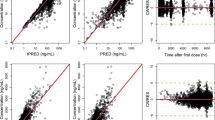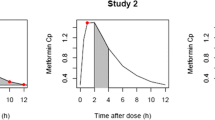Abstract
Background and Objectives
Canagliflozin is an orally active, reversible, selective sodium-glucose co-transporter-2 inhibitor. A population pharmacokinetic (popPK) model of canagliflozin, including relevant covariates as sources of inter-individual variability, was developed to describe phase I, II, and III data in healthy volunteers and in patients with type 2 diabetes mellitus (T2DM).
Methods
The final analysis included 9061 pharmacokinetic (PK) samples from 1616 volunteers enrolled in nine phase I, two phase II, and three phase III studies and was performed using NONMEM® 7.1. Inter-individual variability was evaluated using an exponential model and the residual error model was additive in the log domain. The first-order conditional estimation method with interaction was applied and the model was parameterized in terms of rate constants. Covariate effects were explored graphically on empirical Bayes estimates of PK parameters, as shrinkage was low. Clinical relevance of statistically significant covariates was evaluated. The predictive properties of the model were illustrated by prediction-corrected visual predictive checks.
Results
A two-compartment PK model with lag-time and sequential zero- and first-order absorption and first-order elimination best described the observed data. Sex, age, and weight on apparent volume of distribution of the central compartment, body mass index on first-order absorption rate constant, and body mass index and over-encapsulation on lag-time, and estimated glomerular filtration rate (eGFR, by MDRD equation), dose, and genetic polymorphism (carriers of UGT1A9*3 allele) on elimination rate constant were identified as statistically significant covariates. The prediction-corrected visual predictive checks revealed acceptable predictive performance of the model.
Conclusion
The popPK model adequately described canagliflozin PK in healthy volunteers and in patients with T2DM. Because of the small magnitude of statistically significant covariates, they were not considered clinically relevant. However, dosage adjustments are recommended for T2DM patients with renal impairment (eGFR ≥60 mL/min/1.73 m2: 100 or 300 mg/day; eGFR of 45 to <60 mL/min/1.73 m2: 100 mg/day).





Similar content being viewed by others
References
FARXIGA®. Prescribing information. 2014. Available at http://www.accessdata.fda.gov/drugsatfda_docs/label/2014/202293s202003lbl.pdf. Accessed 4 Mar 2015.
INVOKANA®. Prescribing information. 2013. Available at http://www.accessdata.fda.gov/drugsatfda_docs/label/2013/204042s204000lbl.pdf. Accessed 14 Apr 2014.
JARDIANCE®. Prescribing information. 2014. Available at http://www.accessdata.fda.gov/drugsatfda_docs/label/2014/204629s204000lbl.pdf. Accessed 6 Mar 2015.
Rosenstock J, Aggarwal N, Polidori D, et al. Dose-ranging effects of canagliflozin, a sodium-glucose cotransporter 2 inhibitor, as add-on to metformin in subjects with type 2 diabetes. Diabetes Care. 2012;35(6):1232–8.
Wright EM, Hirayama BA, Loo DF. Active sugar transport in health and disease. J Intern Med. 2007;261(1):32–43.
Bakris GL, Fonseca VA, Sharma K, Wright EM. Renal sodium-glucose transport: role in diabetes mellitus and potential clinical implications. Kidney Int. 2009;75(12):1272–7.
Devineni D, Morrow L, Hompesch M, et al. Canagliflozin improves glycaemic control over 28 days in subjects with type 2 diabetes not optimally controlled on insulin. Diabetes Obes Metab. 2012;14(6):539–45.
Liang Y, Arakawa K, Ueta K, et al. Effect of canagliflozin on renal threshold for glucose, glycemia, and body weight in normal and diabetic animal models. PloS One. 2012;7(2):e30555.
Nomura S, Sakamaki S, Hongu M, et al. Discovery of canagliflozin, a novel C-glucoside with thiophene ring, as sodium-dependent glucose cotransporter 2 inhibitor for the treatment of type 2 diabetes mellitus. J Med Chem. 2010;53(17):6355–60.
Sha S, Devineni D, Ghosh A, et al. Canagliflozin, a novel inhibitor of sodium glucose co-transporter 2, dose dependently reduces calculated renal threshold for glucose excretion and increases urinary glucose excretion in healthy subjects. Diabetes Obes Metab. 2011;13(7):669–72.
Stenlof K, Cefalu WT, Kim KA, et al. Efficacy and safety of canagliflozin monotherapy in subjects with type 2 diabetes mellitus inadequately controlled with diet and exercise. Diabetes Obes Metab. 2013;15(4):372–82.
Guidance for industry on population pharmacokinetics; availability. Food and Drug Administration, HHS. Notice. Fed Reg. 1999;64(27):6663–4.
Guidance for industry. Pharmacokinetics in patients with impaired renal function. 2010.
Finney DJ. Statistical method in biological assay. 1964.
Bergstrand M, Hooker AC, Wallin JE, Karlsson MO. Prediction-corrected visual predictive checks for diagnosing nonlinear mixed-effects models. AAPS J. 2011;13(2):143–51.
Beal BAS. NONMEM user’s guide VI 1992.
Boeckmann SAB. NONMEM user’s guide V 2011.
Sheiner BA. NONMEM user’s guide VII 1998.
Curry SHW, Whelpton R. Drug disposition and pharmacokinetics. Principles to applications. Wiley; 2011.
Soldin OP, Chung SH, Mattison DR. Sex differences in drug disposition. J Biomed Biotechnol. 2011;2011:187103.
Nicolle LE, Capuano G, Ways K, Usiskin K. Effect of canagliflozin, a sodium glucose co-transporter 2 (SGLT2) inhibitor, on bacteriuria and urinary tract infection in subjects with type 2 diabetes enrolled in a 12-week, phase 2 study. Curr Med Res Opin. 2012;28(7):1167–71.
Devineni D, Curtin CR, Marbury TC, et al. Effect of hepatic or renal impairment on the pharmacokinetics of canagliflozin, a sodium glucose co-transporter 2 inhibitor. Clin Thers. 2015;37(3):610–28 e614.
Filippatos TD, Liberopoulos EN, Elisaf MS. Dapagliflozin in patients with type 2 diabetes mellitus. Ther Advances Endocrinol Metab. 2015;6(1):29–41.
Macha S, Mattheus M, Halabi A, Pinnetti S, Woerle HJ, Broedl UC. Pharmacokinetics, pharmacodynamics and safety of empagliflozin, a sodium glucose cotransporter 2 (SGLT2) inhibitor, in subjects with renal impairment. Diabetes Obes Metab. 2014;16(3):215–22.
Damayanthi D, Polidori D. Clinical pharmacokinetic, pharmacodynamic, and drug–drug interaction profile of canagliflozin, a sodium-glucose co-transporter 2 inhibitor. Clin Pharmacokinet. 2015. doi:10.1007/s40262-015-0285-z.
Devineni D, Manitpisitkul P, Murphy J, Stieltjes H, Ariyawansa J, Di Prospero NA, Rothenberg P. Effect of food on the pharmacokinetics of canagliflozin, a sodium glucose co-transporter 2 inhibitor, and assessment of dose proportionality in healthy participants. Clin Pharmacol Drug Dev. 2015;4:279–86. doi:10.1002/cpdd.151.
Francke S, Mamidi RNVS, Solanki B, Scheers E, Jadwin A, Favis R, Devineni D. In vitro metabolism of canagliflozin in human liver, kidney, intestine microsomes, and recombinant uridine diphosphate glucuronosyltransferases (UGT) and the effect of genetic variability of UGT enzymes on the pharmacokinetics of canagliflozin in humans. J Clin Pharmacol. 2015;55:1061–72. doi:10.1002/jcph.506.
Acknowledgments
The authors are most grateful to the study volunteers for their contributions and to the investigational staff for the medical care. The authors acknowledge Hans Stieltjes for the skillful determination of plasma concentrations of canagliflozin, Nicole Vaccaro for her contribution to the protocol designs, Ashwini Patil (SIRO Clinpharm Pvt. Ltd.) for assistance in preparation of the manuscript (funded by Janssen Research and Development, LLC), and Bradford Challis (Janssen Research and Development, LLC) for additional editorial support. The research was funded entirely by Janssen Research and Development. All authors are employees of Janssen Research and Development and own stock and/or stock options in the company. Canagliflozin is being developed by Janssen Research and Development, LLC, in collaboration with the Mitsubishi Tanabe Pharma Corporation.
Author information
Authors and Affiliations
Corresponding author
Electronic supplementary material
Below is the link to the electronic supplementary material.
Rights and permissions
About this article
Cite this article
Hoeben, E., De Winter, W., Neyens, M. et al. Population Pharmacokinetic Modeling of Canagliflozin in Healthy Volunteers and Patients with Type 2 Diabetes Mellitus. Clin Pharmacokinet 55, 209–223 (2016). https://doi.org/10.1007/s40262-015-0307-x
Published:
Issue Date:
DOI: https://doi.org/10.1007/s40262-015-0307-x




